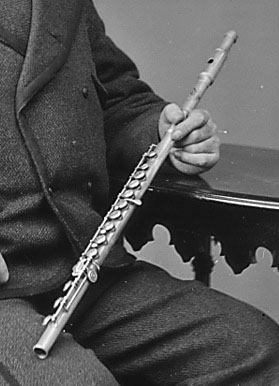Tag: flute
 Wikipedia says: The flute is a family of musical instruments in the woodwind group. Unlike woodwind instruments with reeds, a flute is an aerophone or reedless wind instrument that produces its sound from the flow of air across an opening. According to the instrument classification of Hornbostel–Sachs, flutes are categorized as edge-blown aerophones. A musician who plays the flute can be referred to as a flute player, flautist, flutist or, less commonly, fluter or flutenist.
Wikipedia says: The flute is a family of musical instruments in the woodwind group. Unlike woodwind instruments with reeds, a flute is an aerophone or reedless wind instrument that produces its sound from the flow of air across an opening. According to the instrument classification of Hornbostel–Sachs, flutes are categorized as edge-blown aerophones. A musician who plays the flute can be referred to as a flute player, flautist, flutist or, less commonly, fluter or flutenist.
Flutes are the earliest known identifiable musical instruments, as paleolithic examples with hand-bored holes have been found. A number of flutes dating to about 43,000 to 35,000 years ago have been found in the Swabian Jura region of present-day Germany. These flutes demonstrate that a developed musical tradition existed from the earliest period of modern human presence in Europe. While the oldest flutes currently known were found in Europe, Asia, too, has a long history with the instrument that has continued into the present day. In China, a playable bone flute was discovered, dated approximately 9000 years old. The Americas also had an ancient flute culture, with instruments found in Caral, Peru, dating back 5000 years and in Labrador dating back approximately 7500 years.
Historians have found the bamboo flute has a long history as well, especially in China and India. Flutes have been discovered in historical records and artworks starting in the Zhou dynasty. The oldest written sources reveal the Chinese were using the kuan (a reed instrument) and hsio (or xiao, an end-blown flute, often of bamboo) in the 12th–11th centuries B.C., followed by the chi (or ch’ih) in the 9th century B.C. and the yüeh in the 8th century B.C. Of these, the chi is the oldest documented cross flute or transverse flute, and was made from bamboo.
The cross flute (Sanskrit: vāṃśī) was “the outstanding wind instrument of ancient India,” according to Curt Sachs. He said that religious artwork depicting “celestial music” instruments was linked to music with an “aristocratic character.” The Indian bamboo cross flute, Bansuri, was sacred to Krishna, and he is depicted in Hindu art with the instrument. In India, the cross flute appeared in reliefs from the 1st century A.D. at Sanchi and Amaravati from the 2nd–4th centuries A.D.
Although there had been flutes in Europe in prehistoric times, in more recent millennia the flute was absent from the continent until its arrival from Asia, by way of “North Africa, Hungary, and Bohemia,” according to historian Alexander Buchner. The end-blown flute began to be seen in illustration in the 11th century. Transverse flutes entered Europe through Byzantium and were depicted in Greek art about 800 A.D. The transverse flute had spread into Europe by way of Germany, and was known as the German flute.
Types of flutes
In its most basic form, a flute is an open tube which is blown into. After focused study and training, players use controlled air-direction to create an airstream in which the air is aimed downward into the tone hole of the flute’s headjoint. There are several broad classes of flutes. With most flutes, the musician blows directly across the edge of the mouthpiece, with 1/4 of their bottom lip covering the embouchure hole. However, some flutes, such as the whistle, gemshorn, flageolet, recorder, tin whistle, tonette, fujara, and ocarina have a duct that directs the air onto the edge (an arrangement that is termed a “fipple”). These are known as fipple flutes. The fipple gives the instrument a distinct timbre which is different from non-fipple flutes and makes the instrument easier to play, but takes a degree of control away from the musician.
Another division is between side-blown (or transverse) flutes, such as the Western concert flute, piccolo, fife, dizi and bansuri; and end-blown flutes, such as the ney, xiao, kaval, danso, shakuhachi, Anasazi flute and quena. The player of a side-blown flute uses a hole on the side of the tube to produce a tone, instead of blowing on an end of the tube. End-blown flutes should not be confused with fipple flutes such as the recorder, which are also played vertically but have an internal duct to direct the air flow across the edge of the tone hole.
Flutes may be open at one or both ends. The ocarina, xun, pan pipes, police whistle, and bosun’s whistle are closed-ended. Open-ended flutes such as the concert flute and the recorder have more harmonics, and thus more flexibility for the player, and brighter timbres. An organ pipe may be either open or closed, depending on the sound desired.
Flutes may have any number of pipes or tubes, though one is the most common number. Flutes with multiple resonators may be played one resonator at a time (as is typical with pan pipes) or more than one at a time (as is typical with double flutes).
Flutes can be played with several different air sources. Conventional flutes are blown with the mouth, although some cultures use nose flutes. The flue pipes of organs, which are acoustically similar to duct flutes, are blown by bellows or fans.
Showing the single result
